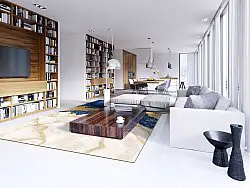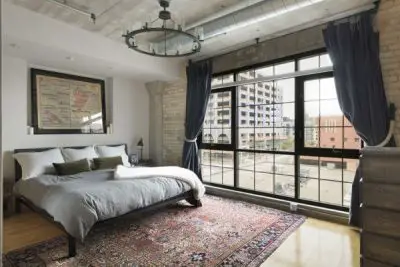Have you ever wondered, “What size rug do I need?” It’s a question that often comes to mind when we’re trying to spruce up our living spaces and create a cozy, stylish atmosphere. Choosing the right rug size is actually a crucial aspect of interior design that many of us tend to overlook.
Whether it’s for your living room, dining area, or bedroom, the size of the rug can truly make or break the overall look and feel of the room. Not only does the perfect rug tie everything together, but it also adds a level of comfort underfoot and helps define different areas within an open floor plan.
What size rug do I need for a small living room?

When it comes to selecting the right size rug for a small living room, there are a few essential considerations to keep in mind. The goal is to find a rug that enhances the space without overwhelming it. Here are some tips to help you choose the ideal rug size:
- Measure the Living Room: Before you start shopping for a rug, measure your living room to determine the available space. Take note of any furniture placement, so you can plan how the rug will fit in the room.
- Leave Some Space Around the Edges: In a small living room, it’s essential to leave a bit of floor space visible around the edges of the rug. This creates a sense of openness and prevents the room from feeling cramped. A good rule of thumb is to leave about 8 to 12 inches of floor visible on all sides of the rug.
- Consider the Furniture Layout: If you have a small seating area, you can opt for a rug that fits underneath the front legs of the sofa and chairs. This helps anchor the furniture and creates a cohesive look. Alternatively, you can choose a slightly larger rug that accommodates all the furniture in the living room, but ensure that it doesn’t extend wall-to-wall, as that can make the room feel smaller.
- Shape Matters: In a small living room, rectangular or square rugs tend to work best. These shapes align well with the furniture arrangement and can make the room appear more organized.
- Lighter Colors and Patterns: Opt for rugs with lighter colors or subtle patterns to make the space feel more open and airy. Dark or bold patterns may make the room look more closed in.
- Consider Layering: If you have a rug that’s slightly smaller than what you’d like, you can consider layering it on top of a larger, neutral rug to achieve the desired size and add some texture to the space.
Ultimately, the ideal rug size for a small living room will depend on the specific dimensions of the room and your furniture layout. By following these guidelines and experimenting with different sizes, you can find the perfect rug that enhances your small living room and adds a touch of warmth and style without overwhelming the space.
How do I determine the right rug size for my dining room?
Choosing the right rug size for your dining room is essential as it can greatly impact the overall look and functionality of the space. Here are some steps to help you determine the appropriate rug size:
- Measure your dining table: Start by measuring the length and width of your dining table. This will be your reference point for selecting the rug size.
- Add extra space: To accommodate the dining chairs comfortably, add an extra 24 to 36 inches (61 to 91 cm) to each side of the table. This allows enough space for the chairs to remain on the rug even when they are pulled out.
- Measure the dining area: Measure the length and width of the area where the dining table and chairs will be placed. This will help you understand the maximum dimensions for the rug.
- Choose a rug size: Based on the measurements you have taken, select a rug size that is closest to the dining area size you measured. It’s generally recommended to choose a rug that is at least 8 to 24 inches (20 to 61 cm) larger than the dining table on all sides.
- Visualize the rug: You can use painter’s tape or newspaper to create a mock outline of the rug size you are considering on the floor. This will help you visualize how the rug will fit in the dining room and give you a better sense of its proportions.
- Consider the room layout: Take into account the overall layout of the dining room. If the dining area is part of an open floor plan, ensure the rug complements the neighboring areas’ rug sizes and styles.
- Shape of the rug: While rectangular rugs are the most common choice for dining rooms, you can also consider round or square rugs depending on the shape of your dining table and the overall room design.
- Maintenance: Keep in mind that dining areas are prone to spills and messes, so choose a rug material that is easy to clean and durable, such as stain-resistant materials or easy-to-clean synthetic fibers.
- Budget: Rugs come in various price ranges, so consider your budget when making your final decision.
Remember that the right rug size can tie the dining room together and provide a comfortable and inviting space for your meals. If you’re unsure about the size, it’s better to go slightly larger than too small, as an undersized rug may look out of place and make the dining area feel disconnected.
What size rug should I choose for a bedroom?

The size of the rug you choose for your bedroom will depend on the size of your bed, the other furniture in the room, and your personal preferences. However, there are a few general rules of thumb that can help you choose the right size rug.
- A rug should extend at least 18 to 24 inches beyond the edges of the bed on all sides. This will create a sense of visual balance and make the room feel more spacious.
- If you have other furniture in the bedroom, such as nightstands or a dresser, the rug should also extend under these pieces. This will help to define the space and create a cohesive look.
- If you want to create a more dramatic effect, you can choose a rug that is larger than the bed. This will make the bed appear to float on the rug and create a sense of airiness.
- If you have a small bedroom, you may want to choose a smaller rug. This will help to make the room feel larger.
How do I measure for a rug in a hallway?
Measuring for a rug in a hallway requires a different approach compared to measuring for a room. Here’s a step-by-step guide to help you measure for a hallway rug:
- Measure the width of the hallway: Use a tape measure to determine the width of the hallway from one wall to the opposite wall. Make sure to measure at the widest point of the hallway, including any nooks or alcoves if applicable.
- Measure the length of the hallway: Next, measure the length of the hallway from one end to the other. If your hallway has any turns or bends, measure each straight section separately and add the measurements together to get the total length.
- Consider furniture and doors: Take note of any furniture or doors in the hallway. If you have furniture against the walls, consider whether you want the rug to extend under the furniture or stop before it. Also, ensure that the doors can open and close freely over the rug without any obstructions.
- Allow space at the ends: It’s generally best to leave some space at the ends of the hallway without a rug. Aim for around 6 to 12 inches (15 to 30 cm) of bare floor on each end to create a balanced and visually appealing look.
- Shape of the rug: Hallways are typically narrow and long, so rectangular rugs are the most common choice. However, if your hallway has a wider area or unique shape, you can also consider using a runner rug, which is a long, narrow rug specifically designed for hallways.
- Choose the rug size: Based on your measurements and preferences, select a rug size that fits the hallway’s dimensions and complements the overall style of the space. For a hallway runner, choose a length that covers most of the hallway’s length, leaving some space at the ends.
- Consider a non-slip rug pad: Hallway rugs can be prone to slipping, especially on hardwood or tile floors. To prevent accidents and keep the rug in place, consider using a non-slip rug pad underneath the rug.
Keep in mind that hallways are high-traffic areas, so choose a rug material that can withstand frequent foot traffic and is easy to clean. Additionally, consider the hallway’s color scheme and decor when selecting a rug to ensure it blends well with the existing design.
What size rug is suitable for a round dining table?
Choosing the right size rug for a round dining table involves considering both the size of the table and the space needed for chairs to comfortably fit on the rug when they are pulled out.
Here are some guidelines to help you determine the suitable rug size:
- Measure the diameter of the dining table: Start by measuring the diameter of your round dining table. This is the distance across the tabletop from one side to the other, passing through the center.
- Add extra space for chairs: To ensure that the chairs remain on the rug when pulled out, add approximately 24 to 30 inches (61 to 76 cm) to the table’s diameter. This will provide enough space for the chairs to sit on the rug without slipping off the edge.
- Choose a rug size: Once you have calculated the total diameter (table diameter + extra space for chairs), you can choose a round rug that is closest to that size. If you can’t find an exact match, it’s generally better to go slightly larger than smaller.
- Consider the room layout: Take into account the size of the dining area and the space available around the table. Ensure that the rug size you choose fits well within the room and leaves enough space to move around comfortably.
- Visualize the rug: You can use painter’s tape or a large circular object (like a hula hoop or a piece of cardboard) to create a mock outline of the rug size you are considering on the floor. This will help you visualize how the rug will look in the dining area and how much it will cover.
- Shape of the rug: As you are working with a round dining table, the most appropriate rug shape is, of course, a round rug. This shape complements the table’s design and provides a cohesive look.
- Material and maintenance: Since dining areas are prone to spills and stains, choose a rug material that is easy to clean and maintain, such as stain-resistant materials or durable synthetic fibers.
By following these steps, you can select a round rug size that enhances the dining area’s aesthetics while ensuring a comfortable and functional space for dining.
How do I select the right rug size for an open-concept space?
Selecting the right rug size for an open-concept space requires careful consideration of the room’s layout, furniture arrangement, and overall aesthetic. An open-concept space typically combines two or more areas, such as a living room, dining area, and kitchen, into one larger space without walls or dividers.
Here are some tips to help you choose the right rug size for such a space:
- Define areas within the space: First, identify the different functional areas within the open-concept space. For example, determine the living room seating area, dining area, and any other specific zones you want to highlight.
- Measure the space: Measure the entire area of the open-concept space, and then measure the individual areas within it. This will help you understand the scale of the space and the dimensions of the separate zones.
- Leave enough border space: When selecting a rug size, it’s essential to leave enough floor space around the edges of the rug. A general rule of thumb is to leave at least 12-18 inches of floor visible around the perimeter of the rug. This will help create a balanced and visually appealing look.
- Living room seating area: In the living room area, choose a rug that is large enough to accommodate all the furniture within the seating arrangement. The front legs of sofas and chairs should ideally be on the rug, while the back legs can be off. This creates a cohesive and connected feel.
- Dining area: For the dining area, select a rug that is large enough to accommodate the dining table and chairs, even when they are pulled out for seating. Add approximately 24 inches to each side of the table to ensure ample space.
- Connecting the spaces: If the open-concept space has multiple functional zones, consider using different rugs for each area. However, it’s crucial to ensure that the rugs complement each other in terms of style and color to create a cohesive look.
- Visual continuity: If you prefer to use a single rug for the entire open-concept space, make sure it’s large enough to cover the primary living and dining areas adequately. This will visually connect the spaces while still defining distinct areas.
- Consider shapes: Rugs come in various shapes, including rectangular, square, round, and even custom shapes. Choose a shape that complements the layout and furniture arrangement of each zone in the open-concept space.
- Experiment and visualize: If you’re unsure about the rug size, use painter’s tape or bed sheets to mark out different rug sizes on the floor. This will help you visualize how each size affects the overall appearance of the space.
Remember, the right rug size can significantly impact the overall look and feel of your open-concept space. Taking the time to measure and plan before making a purchase will ensure you find the perfect rug that enhances the beauty and functionality of the entire area.
What size rug is best for a large family room?
The best rug size for a large family room depends on the size of the room, the furniture in the room, and your personal preferences. However, there are a few general guidelines that you can follow to ensure that you choose the right size rug.
- The rug should be at least 70% of the floor space in the room. This will help to define the living space and make it feel more cozy and inviting.
- The rug should be large enough to accommodate all of the furniture in the room. This means that the front legs of all of the furniture should be on the rug.
- There should be at least 18-24 inches of space between the rug and the walls. This will create a walkway and prevent the rug from bunching up against the walls.
Here are some specific rug sizes that would be appropriate for a large family room:
- 9×12 feet is a good size for a large family room with a standard-sized sofa and coffee table.
- 10×14 feet is a good size for a large family room with a large sofa and coffee table, or for a family room that is used for entertaining.
- 12×16 feet is a good size for a very large family room, or for a family room that is used for both casual and formal gatherings.
Ultimately, the best way to choose the right rug size for your large family room is to measure the room and the furniture, and then experiment with different sizes until you find one that you like.
How do I measure for a rug in front of the fireplace?
Measuring for a rug in front of the fireplace is a task that requires some careful consideration to ensure a perfect fit and aesthetic appeal. Let’s go through the steps as if I’m guiding you in person:
- Get Your Measuring Tools Ready: First things first, grab a measuring tape or a ruler, a piece of paper, and a pen or pencil. Having these tools handy will make the process much easier.
- Decide on the Rug Size: Before you start measuring, consider the size of the rug you want. This decision will depend on your personal preferences and the dimensions of the space in front of the fireplace. Some people prefer a small accent rug, while others may want a larger one that covers a significant portion of the area.
- Clear the Space: Make sure the area in front of the fireplace is clear of any furniture or obstacles. This will give you a clear and accurate measurement of the available floor space.
- Measure the Length: Starting from one side of the fireplace, place the end of the measuring tape or ruler flush against the edge of the hearth or any existing rug or floor covering. Extend the tape or ruler across the floor to the other side of the fireplace. Note down this length measurement.
- Measure the Width: Next, move to the front of the fireplace, align the measuring tape with the base of the fireplace or the edge of the existing rug/floor covering, and extend it perpendicular to the length measurement you just recorded. Note down this width measurement.
- Allow for Clearance: If you have any doors or furniture near the area, consider leaving some clearance space around the rug to ensure everything fits harmoniously. Generally, a few inches of clearance will do the trick.
- Consider the Rug Shape: Depending on the shape of your fireplace and the surrounding area, you might opt for a rectangular, square, round, or oval-shaped rug. Choose the shape that complements the overall aesthetics of the space.
- Double-Check the Measurements: To ensure accuracy, it’s a good idea to double-check your measurements. Measure the length and width again to confirm they match your initial measurements.
- Shop for the Rug: Armed with your measurements, head to a rug store or shop online to find the perfect rug for your fireplace area. Remember to consider the rug material, color, and design that suits your style and complements the existing decor.
- Placement and Styling: Once you have your new rug, place it in front of the fireplace, making sure it aligns with your measurements. Arrange the furniture, if any, around the rug to create a cozy and inviting atmosphere.
Remember, a well-chosen rug can add warmth and character to your fireplace area, so take your time in finding the right one that fits your space and personal taste.
What size rug do I need for a compact entryway?

For a compact entryway, you’ll want to choose a rug size that fits the space well while providing a welcoming and functional element. Here are some tips to help you determine the appropriate rug size for your compact entryway:
- Measure the Entryway Area: Use a measuring tape to determine the dimensions of your entryway. Measure the width and length of the area where you intend to place the rug.
- Allow for Clearance: Consider leaving some clearance space around the rug to ensure that the entry door can open and close freely without catching on the rug. Aim for at least 6-12 inches of clearance on all sides.
- Choose a Small Rug: Given the compact size of the entryway, a small rug will likely work best. Opt for a rug that is proportional to the size of the entryway, without overwhelming the space.
- Rectangular or Runner Rug: In most compact entryways, rectangular or runner rugs are ideal choices. A runner rug is a long, narrow rug that can add visual interest while also fitting well in narrow entryways.
- Consider Shape: Depending on the shape of your entryway, you might also consider round or oval rugs, which can soften the space and create a welcoming focal point.
- Pattern and Color: Choose a rug with a pattern or color that complements your entryway’s decor and sets the tone for the rest of your home. Lighter colors can make the space feel more open and airy, while darker colors can add coziness.
- Functional Purpose: Keep in mind that entryways are high-traffic areas, so look for a durable and easy-to-clean rug that can handle the foot traffic and occasional dirt.
- Non-Slip Rug Pad: To ensure safety and prevent the rug from slipping on smooth flooring surfaces, consider using a non-slip rug pad underneath the rug.
- Test the Look: If possible, use painter’s tape or newspapers to create an outline of the rug’s dimensions on the floor. This will help you visualize how the rug will fit in the entryway and if it’s the right size.
As entryways can vary in size, there is no one-size-fits-all answer for the perfect rug size. However, by measuring the area, allowing for clearance, and choosing an appropriate rug size and shape, you can find a rug that enhances your compact entryway’s aesthetics and functionality.
What size rug should I choose for a galley kitchen?
For a galley kitchen, the right size rug would be one that fits the space comfortably while providing a practical and visually appealing addition. Since galley kitchens are typically narrow with a linear layout, a runner rug is the most suitable option. Here’s the recommended size:
Choose a runner rug with dimensions around 2.5 feet (30 inches) wide and 6 to 10 feet long.
The specific length within this range will depend on the length of your galley kitchen. Measure the available floor space and choose a runner rug that’s proportional to the kitchen’s length, leaving a few inches of clearance on either end.
A runner rug of this size will add warmth to the kitchen, protect the flooring, and create a defined pathway in the narrow space. Additionally, it’s important to select a durable and easy-to-clean rug material, as kitchens are high-traffic areas prone to spills and messes.
Conclusion
You will get to learn a lot on this topic that says what size rug do I need. When choosing the size of a rug, consider the dimensions of the area where you plan to place it. For a compact entryway, opt for a small rug that fits well, leaving some clearance around it.
A runner rug around 2.5 feet wide and 6 to 10 feet long is ideal for a galley kitchen, providing both functionality and visual appeal. Remember to choose a durable and easy-to-clean material, and consider the overall aesthetics to enhance the space’s look and feel.


